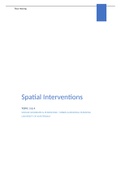Fleur Hessing
Spatial Interventions
TOPIC 3 & 4
SOCIALE GEOGRAFIE & PLANOLOGIE / URBAN & REGIONAL PLANNING
UNIVERSITY OF AMSTERDAM
,Fleur Hessing
Index
Topic 3: Planning for inclusion................................................................................................................3
Lecture 7: The Communicative Turn...................................................................................................3
Healey, P (1996): The communicative turn in planning theory and its implications for spatial
strategy formation..........................................................................................................................3
Allmendinger, P & Tewdwr-Jones, M (2002): The Communicative Turn in Urban Planning:
Unravelling Paradigmatic, Imperialistic and Moralistic Dimensions...............................................6
Innes, J.E, & Booher, D. E (2015): A turning point for planning theory? Overcoming dividing
discourses.......................................................................................................................................8
Lecture 7: The Communicative Turn.............................................................................................10
Workshop Task 4 – Making a conflict analysis..................................................................................13
Jeong, H (2008): Understanding conflict and conflict analysis......................................................13
Lecture 8: Planning and conflict........................................................................................................16
Eranti, V (2017): Re-visiting NIMBY: From conflicting interests to conflicting valuations.............16
Ocejo, R (2020): The Precarious Project and the Wasted Opportunity: The Social and Cultural
Dynamics of Conflict over Urban Development............................................................................17
McAuliffe, C & Rogers, D (2018): Tracing resident antagonisms in urban development..............19
Lecture 8: Planning and conflict....................................................................................................21
Lecture 9: Planning as an exclusionary mechanism..........................................................................23
Yiftachel, O (1998): Planning and social control: Exploring the dark side.....................................23
Watson, V (2009): The planned city sweeps the poor away.........................................................25
Thomas, J (2008): The Minority-Race Planner in the Quest..........................................................30
Lecture 9: Planning as an Exclusionary Mechanism......................................................................32
Lecture 10: Planning, Imagination and Futuring...............................................................................35
Connell, D. J. (2009): Planning and its Orientation to the Future.................................................35
Savani, F. (2019): Crafted imagination: Future-builders and the contemporary logic of
experimentalism...........................................................................................................................36
Pelzer, P. & Versteeg, W. (2019): Imagination for change: The Post-Fossil City Contest..............38
Lecture 10: Planning, Imagination and Futuring...........................................................................40
Workshop Task 5 - Scenario planning with Ed Dammers (PBL).........................................................43
Chapter 2 in PBL (2019). Building scenarios for environmental, nature and spatial planning policy
......................................................................................................................................................43
Chapter 2 in PBL (2019) Using scenarios for environmental, nature and spatial planning policy. 47
Workshop Task 5: Building and using scenarios...............................................................................50
Lecture 11: Urban Complexity and Self-Organisation.......................................................................54
Rauws, W. (2016): Civic initiatives in urban development: Self-governance versus self-
organisation in planning practice..................................................................................................54
1
,Fleur Hessing
Silvia, P. (2016): Tactical urbanism: Towards and evolutionary cities’ approach?........................56
Lecture 11: Urban Complexity and Self-Organisation...................................................................58
Lecture 12: Informality and DIY urbanism........................................................................................60
Kickert, C & Arefi, M (2019); Introduction in Palgrave Handbook of Bottom-Up Urbanism.........60
Metha, V (2019): Space, Time, and Agency on the Indian Street..................................................62
Devlin, R (2018): Asking ‘Third World questions; of First World informality.................................63
Douglas, G (2018): Privilege and Participation: On the Democratic Implication and Social
Contradictions of Bottom-Up Urbanisms......................................................................................65
Lecture 12: Informality and DIY urbanism....................................................................................66
2
, Fleur Hessing
Topic 3: Planning for inclusion
Lecture 7: The Communicative Turn
Healey, P (1996): The communicative turn in planning theory and its
implications for spatial strategy formation
Economic and political orders have changed
Urban regions: coexistence of social and economic relations, linking people in a place with
those in other places, but not necessarily with those in the same place
tensions and conflicts
The quality of places has become important in regional economic development and in the
struggle to avoid further environmental deterioration
urban regions are now in competition with one another
Paradigm shift (Kuhn): many small contributions add up to a sea change in the parameters of our
thinking
Two waves in the 20th century: vocabulary of instrumental rationality and regional economics +
substantive understand of the power relations of urban region economies
Political economy policy processes in terms of power struggles: heavily on material
conditions
The new wave: cultural diversity; we are diverse people living in complex webs of economic and
social relations
- How do we get to discuss issues in the public realm?
- Habermas: our sense of ourselves and of our interests is constituted through our relations
with others
Ideas in different fields, all interrelating with new directions in the theorization of social relations and
the dynamics of social and economic change
The recognition of the collective significance of these strands of thinking: new planning approach
Communicative approach and its implications:
1. An interactive and interpretative process
2. Undertaken among diverse and fluid discourse communities
3. In ways which require respectful interpersonal and intercultural discussion
4. On the arenas where public discussion takes place and where problems are identified
5. On the multiple claims made for policy attention
6. On ways of developing critical, reflexive capacity, generating and testing ideas
7. On ways of opening out strategic discourse in forms which inclusionary
8. Participants will learn new things about themselves and their relations
9. Participants will collaborate to change the way things are; transform situations
10. Dreaming the possibility of change; a process dream
3





